Home » Three roll mill: A Machine Used To Mix, Fefine, or Disperse Materials
Three roll mill: A Machine Used To Mix, Fefine, or Disperse Materials
Hydraulic Three Roll Mill
The three-roll mill is a crucial piece of equipment used for the grinding and dispersing of various materials such as paints, inks, pigments, plastics, cosmetics, soaps, ceramics, rubber, and other liquid slurries and paste-like substances. It is a machine that uses shear force created by three horizontally positioned rolls rotating in opposite directions and at different speeds relative to each other to mix, refine, disperse, or homogenize viscous materials fed into it.
Details of Three Roll Mill
- Two types: handwheel and digital control gap
- Safe scraper socket, Emergency-stop
- Space-saving desktop models
- Drip tray for easy cleaning
Application: Paint, Adhesive, Battery, Pharmaceutical industry, Cosmetic
A three roll mill is a machine used to mix, refine, or disperse materials such as pigment, inks, or other substances that require finely dispersed particles. The mill consists of three horizontally positioned rolls rotating in opposite directions at different speeds. This configuration allows for the efficient grinding, dispersion, and homogenization of the materials.
Design and Construction of Three Roll Mill
The three-roll mill consists of three horizontally positioned rolls that rotate in opposite directions. The rolls are typically made of different materials such as stainless steel, alumina, silicon carbide, and zirconia to meet various needs
The Importance of Grinding
The machine can adjust the distance between each roller with a touch screen to ensure perfect parallelism of the rollers. The elastically tensioned blade socket ensures constant blade pressure and does not require readjustment during operation
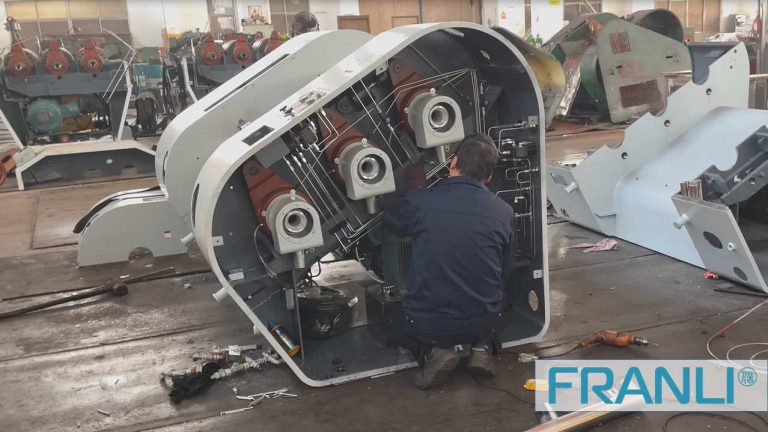
Parts of Three Roll Mill
The main parts of the three-roll mill include
Rollers: Three horizontally positioned rolls that rotate in opposite directions to mix, refine, disperse, or homogenize viscous materials fed into the mill.
Blade Socket: Elastically tensioned blade socket that ensures constant blade pressure and does not require readjustment during operation.
Control Panel: A touch screen control panel to adjust the distance between each roller to ensure perfect parallelism of the rollers.
How Three Roll Mill Works
The three-roll mill works by feeding material, usually in paste form, between the center roll and the feed roll. The material is subjected to progressively higher speeds as it passes through the adjacent rolls. This subjects it to an even higher shear force, due to the higher speed of the apron roll and typically, a smaller gap than between the feed and center rolls. A knife blade then scrapes the processed material off the apron roll, and the paste rolls down the apron. This milling cycle can be repeated several times to maximize dispersion
Advantages of Three Roll Mill
The three-roll mill offers several advantages, including:
High Dispersion and Emulsification Effect: The three-roll mill provides excellent dispersing and emulsification effects, especially for ink, paint, colloid, chocolate, plastic, and cosmetics, whether it is liquid slurry or paste material.
Wide Range of Applications: Three-roll mills are widely used to mix printing inks, electronic thick film inks, high-performance ceramics, cosmetics, plastisols, carbon/graphite, paints, pharmaceuticals, chemicals, glass coatings, dental composites, pigment, coatings, adhesives, sealants, and foods.
Customizable Roller and Scraper Materials: Rollers of different materials can be used, from stainless steel to alumina, silicon carbide, and zirconia, to meet various needs.
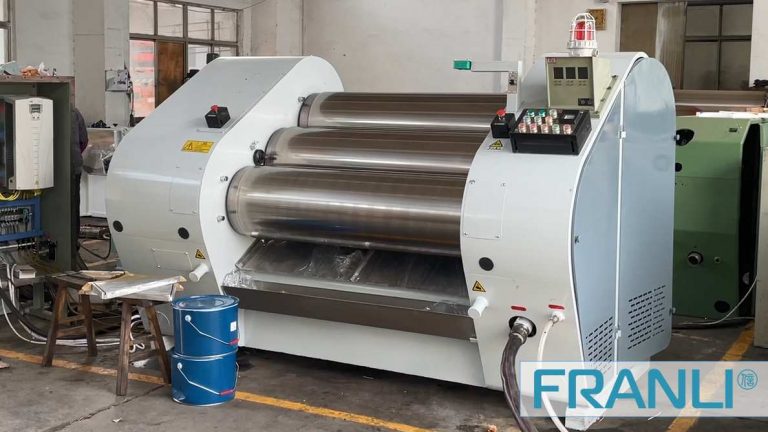
The primary functions of a three roll mill include:
Grinding and Dispersion: The primary function of the three roll mill is to grind and disperse the pigment particles within a liquid medium. As the pigment and liquid are fed between the rolls, the high shear forces and pressure exerted by the rotating rolls effectively break down agglomerates and disperse the pigment particles evenly throughout the liquid.
Particle Size Reduction: The three roll mill is capable of reducing the particle size of the pigment to achieve the desired fineness. By adjusting the gap between the rolls, operators can control the degree of particle size reduction, ensuring that the pigment particles are finely ground to the required specifications.
Homogenization: In addition to grinding and dispersion, the three roll mill facilitates the homogenization of the pigment and liquid mixture. Through the repeated shearing and mixing action of the rolls, the mill ensures that the pigment particles are uniformly distributed and that the mixture achieves a consistent, homogeneous composition.
Temperature Control: Some advanced three roll mills are equipped with cooling or heating mechanisms to control the temperature of the grinding process. This feature is particularly important for pigment grinding, as it helps prevent overheating and maintains the stability of the pigment dispersion.
Adjustable Operating Parameters: Three roll mills offer flexibility in adjusting various operating parameters such as roll speed, roll pressure, and gap distance. These adjustments allow operators to optimize the grinding process based on the specific characteristics of the pigment and the desired outcome.
The machine functions of a three roll mill for pigment grinding encompass grinding and dispersion of pigment particles, particle size reduction, homogenization of the pigment mixture, temperature control, and adjustable operating parameters. These functions collectively enable the mill to achieve precise and consistent pigment dispersion for various applications in industries such as coatings, inks, and cosmetics.
The three-roll mill is a vital piece of equipment used for the grinding and dispersing of various materials such as paints, inks, pigments, plastics, cosmetics, and more. Its design and construction, including the adjustable rollers and blade socket, make it an effective tool for achieving high dispersion and emulsification effects. The machine’s wide range of applications and customizable roller and scraper materials make it a versatile and essential tool in various industries.
FRANLI manufactures all types of three roll mills and designs the best solutions for different materials. As a three roll mill manufacturer with 20 years of experience, FRANLI has a team of experts in the design of a complete line and provides permanent pre-and post-sales service.
Welcome to send inquiry to us and let’s make a win win business together !
Guidelines For Three Roll Mill
Three roll mills are widely used in a variety of chemical industries, from medium to high viscosity productions. FRANLI machine can break open all kinds of pigment, UV ink, offset ink, decorative paints, and Lubricants, it also can catch the greatest fineness in cosmetics/ lipstick and electronics industries.
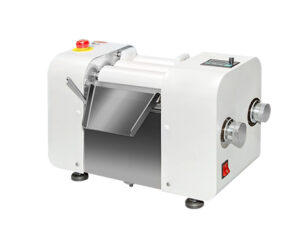
Three Roll Mill For Carbon Black|High Grinding & Dispersion
Three roll mill is the main equipment for grinding colored carbon black, as it is used extensively in rubber, plastics, paints, and inks, and some carbon black is added.
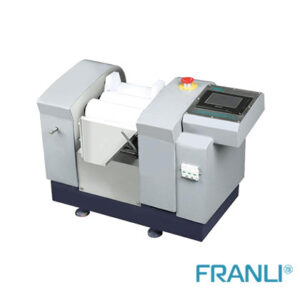
Laboratory Three Roll Mill|PLC Control System & Experimental
The laboratory three roll mill is equipped with the most advanced PLC functions to continuously improve the operability of the most primitive production equipment.

Three Roll Mill For Grease
The three roll mill plays a vital role in the grinding of grease. Grease is essentially a kind of lubricating oil, which is a solid or semi-solid product formed by one or more thickeners through the grinding and dispersing action of a three roll mill.

Three Roll Mill For Attapulgite
Three roll mill is the main equipment for grinding attapulgite. The attapulgite is ground and dispersed mainly because it is a natural colloid. Even if the size of the attapulgite reaches 0.1mm, it cannot be easily dispersed by the machine, so the final state of attapulgite formation has been greatly developed.
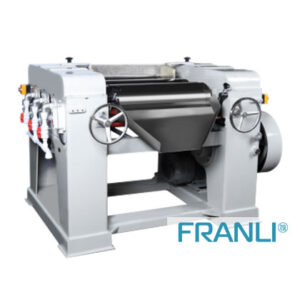
Rolls of a three-roll mill
The three-roll mill is mainly used for grinding materials of various viscosities and is one of the best wet grinding equipment. The dispersing and emulsification effect of the three-roll mill is excellent, especially for ink, paint, colloid, chocolate, plastic, cosmetics, etc., whether it is liquid slurry or paste material, the three-roll mill can work easily.

3 roll mill|Failure of the roll shaft & pulley
The 3 roll mill is a grinding and dispersing equipment, which plays an irreplaceable role in improving the quality of coating products.

